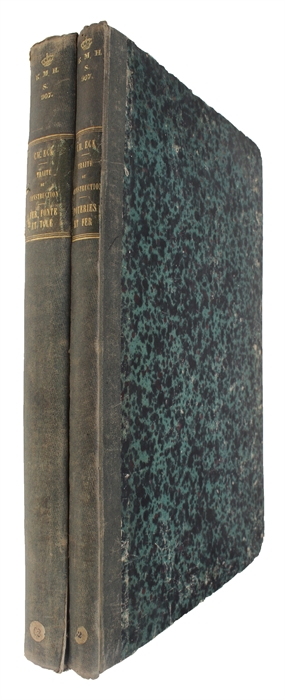ECK, CH.L.G.
Application Générale du Fer, de la Fonte, de la Tôle et des Poteries dans les Constructions Civiles, Industrielles et Militaires, dans celles des Ponts Fixes ou Suspendus, des Chemin de Fer, des Ecluses et Digues a la Mer, etc. etc. 2 vols. (Vol. 1 deuxieme tirage). I: Traite des Construction en Poteries et Fer,...suivi d'un Recueil de Machines appropriées a L'Art de Batir. II: Traite de L'Application du Fer, de la Fonte et de la Tôle. Memoire sur la Construction de Nouveaux Planchers destinées a rendre les Batiments Incombustibles. Par P.-D. Bazaine.
Paris, 1841.
Folio. Bound in 2 modest cont. hcloth. Tear in lower part of back on volume II. Backs somewhat rubbed. (8),72,22-(6),116,8,32 pp. and 146 engraved plates (ca 40 x 22) cm). Stamp on titles. Vol. I occasionally slightly brownspotted.
Scarce first edition (volume 1 in second issue), of this magnificent and highly important work on construction with iron, thoroughly explaining for one of the first times how to generally apply, use and cast iron for the construction of buildings and how to use ceramic pots and wrought-iron together in civil, military, and industrial buildings as well as bridges, rail-roads, etc.
Already in the late 18th century, the great improvements in the manufacture of wrought-iron, following upon the introduction and development of the puddling furnace and the rolling mill, had led to the increased use of it in construction, and especially in France the use of hollow ceramic pots in combination with a wrought-iron framework had proved itself very effective in protection against fire in particular. It was not until a few decades later, though, that the manufacturing techniques of iron had become sufficiently effective for it to be widely used in various large-scale construction, and even during the first decades of the 19th century, almost only the French exploited this new technique.
Eck's major work from 1841 plays a significant role in the spreading of the iron-construction techniques and provides us with important information on the earliest use of iron-construction. After Eck's seminal work, British architects really began understanding the benefits of this sort of construction, and within a few more decades it spread widely beyond the borders of France. In 1854 G.r. Burnel writes in "The Civil Engineer and Architect's Journal" (William Laxton edt.): "I would call your attention, and that of the members of the Institute, to a work I mentioned on the last evening; it is M. Eck's Traité de la Construction, Poteries, Fer, Fonte et Tôle, in two vols. fol. Paris, 1841; in which will be found many very remarkable illustrations of the application of those various materials to purposes which rarely are thought of in England. It is an extremely valuable work, and if it had been better known here, probably much money might have been saved preventing parties from taking out patents for systems already largely employed; and at any rate, the study of M. Eck's book would have suggested many valuable hints to both architects and engineers."
Order-nr.: 18371




